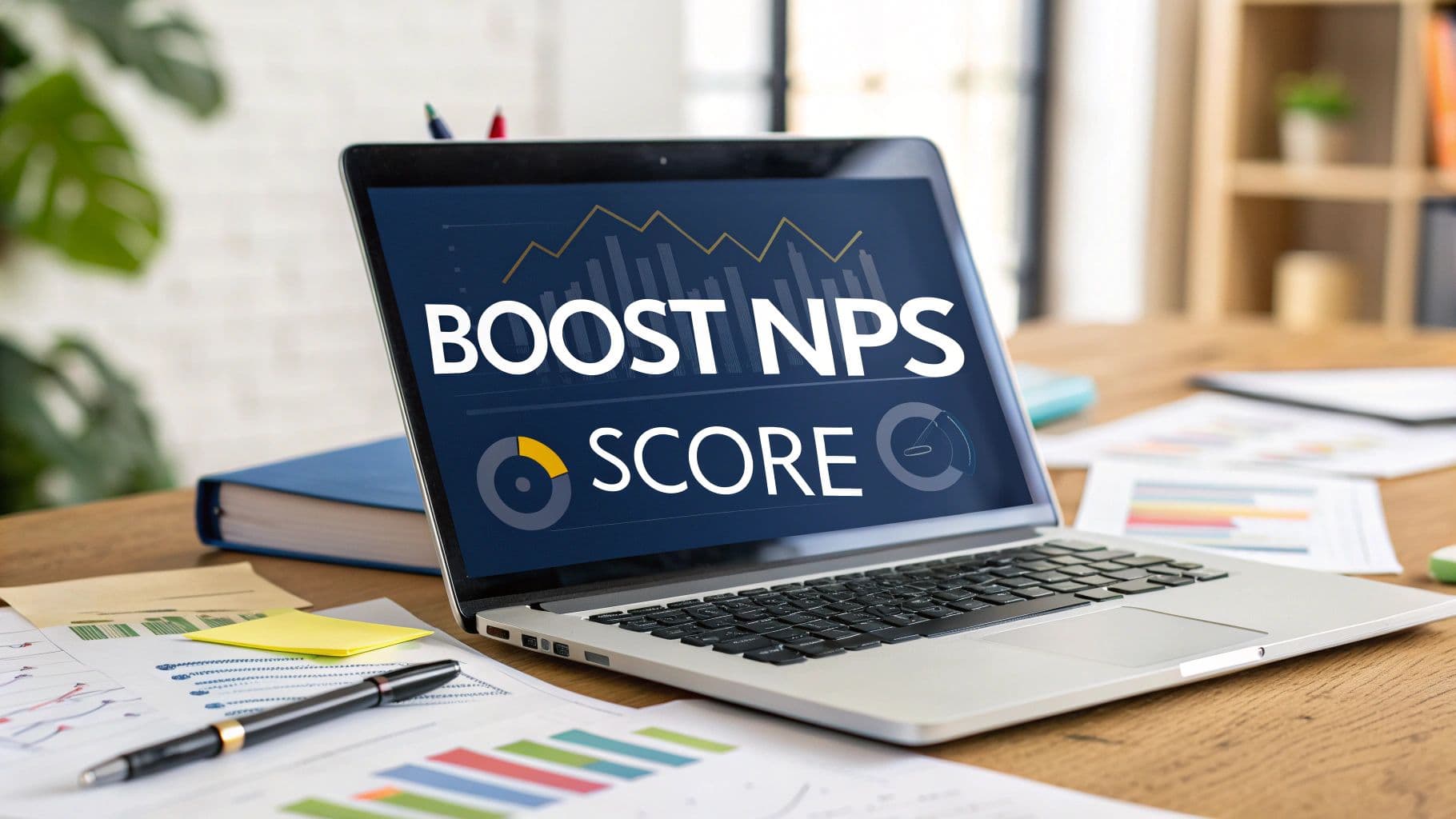customer voice analysis: Turn Feedback into Growth
Discover how customer voice analysis turns feedback into actionable steps that boost loyalty and revenue.
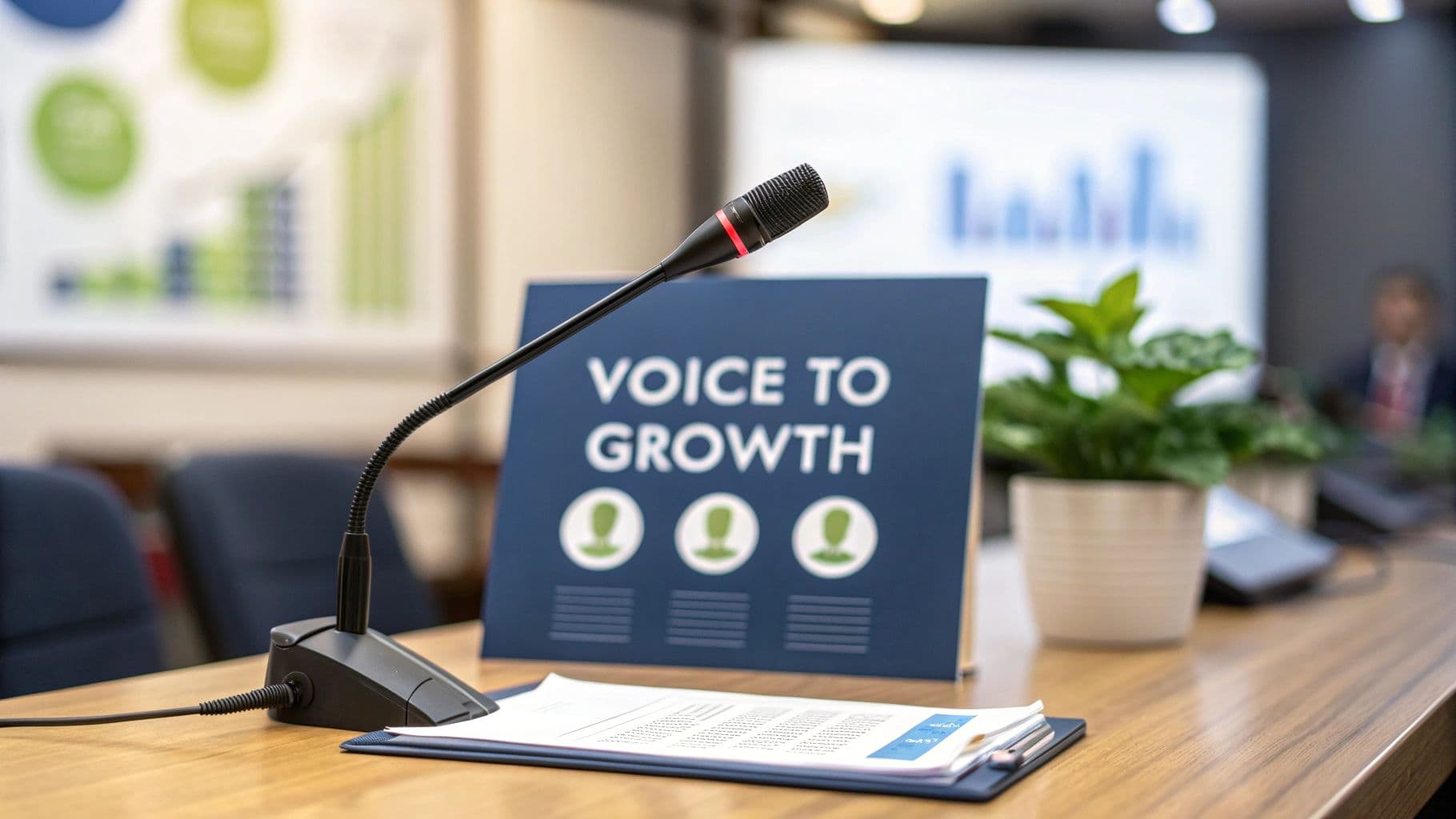
Picture this: you have the power to tune into every single customer conversation, read every review, and absorb every survey response, all at the same time. That's the essence of customer voice analysis. It's a structured way to gather, make sense of, and act on everything your customers are telling you.
This process takes the messy, unstructured chatter from support calls, social media posts, and online reviews and turns it into clear, actionable insights.
The Bedrock of a Customer-First Business
Customer voice analysis is more than just collecting data—it's about digging deep to understand the real meaning behind the words. Think of it as developing a kind of business superpower, one that lets you spot patterns, detect emotions, and uncover unspoken needs across thousands of conversations at once.
Instead of relying on gut feelings or assumptions, you get to make sharp, data-driven decisions that solve real customer problems and deliver what they truly want.
This methodical approach goes way beyond the occasional feedback form. It stitches together data from all the different places customers interact with you, building a complete, 360-degree view of their experience. The whole point is to find concrete answers to your most pressing business questions:
- Why are we losing some of our users?
- Which new features would actually drive more revenue?
- Where are people getting stuck or frustrated when using our product?
Turning Raw Feedback into Smart Decisions
The magic happens when you turn all that qualitative feedback (what people say) into quantitative data (what you can measure). For example, a crucial first step is often taking spoken feedback from phone calls and turning it into text. To see how that works, you can learn what audio transcription is and why it's so important.
Once all this feedback is in a text format, you can start analyzing it for recurring themes and patterns. We break down the entire process in our detailed guide on customer feedback analysis.
It's no surprise that the market for tools that do this is booming. Valued at USD 1.5 billion in 2024, the Voice of the Customer (VoC) tools market is expected to more than double, reaching USD 3.2 billion by 2033. This surge shows just how serious companies are about adopting customer-first strategies powered by data.
By bringing order to this chaos of information, businesses can pinpoint specific gaps in their products, get ahead of customer churn, and build a serious competitive edge. It ensures that your roadmap and strategy are built on what customers actually need, not just what you think they need.
How to Capture Authentic Customer Feedback
Great customer voice analysis starts with one thing: authentic feedback. If you’re only sending out an annual survey, you’re trying to understand an entire city by visiting just one street. You’ll get a snapshot, sure, but you'll miss the real story. To genuinely understand your customers, you have to meet them where they are and listen to what they're saying.
This means building a feedback ecosystem. You need to capture what customers tell you directly when you ask, but just as importantly, you need to capture what they say when they think you're not listening. It's the combination of these two streams that gives you a complete, unfiltered picture of their world.
The journey from raw feedback to real business impact can be broken down into three core stages.
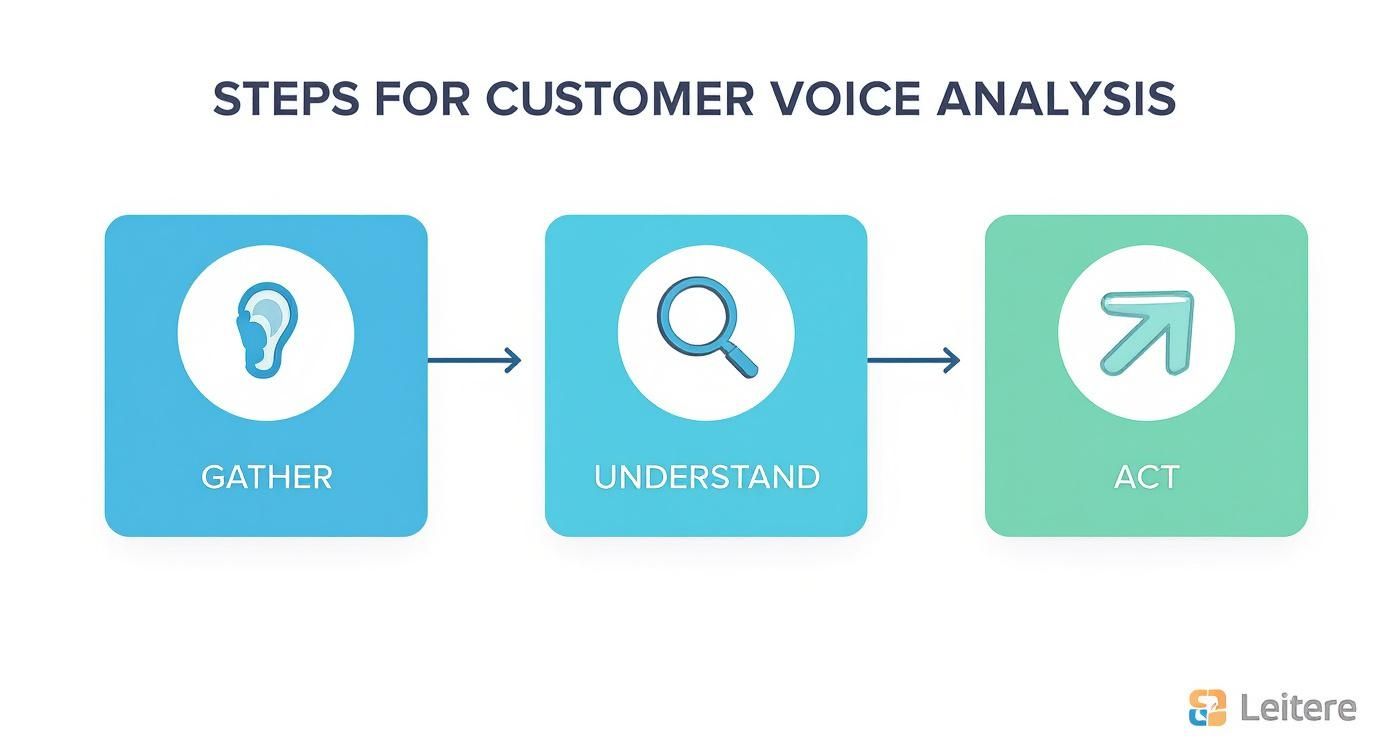
This process shows how to turn scattered comments and data points into clear actions that improve your product and drive growth.
Direct Feedback Channels
Direct feedback is what you get when you actively ask customers for their opinion. Think of it as solicited feedback. These methods are fantastic for getting straight answers to specific questions and for tracking key metrics over time. The data you get is often structured, making it easier to quantify and compare.
Here are the go-to methods for direct feedback:
- Surveys: Tools like Net Promoter Score (NPS), Customer Satisfaction (CSAT), and Customer Effort Score (CES) are perfect for setting quantitative benchmarks for loyalty and happiness.
- In-depth Interviews: Nothing beats a one-on-one conversation for digging into a customer's motivations and challenges. This is where you uncover the "why" behind their actions.
- Focus Groups: Getting a small group of users together can ignite conversations and surface shared pain points that individual interviews might not catch.
- Feedback Forms: A simple, always-available form on your website or in your app gives customers an immediate outlet to share their thoughts the moment they have them.
These channels are powerful, but they have one major catch: you’re leading the conversation. The most game-changing insights often hide in the places you aren’t actively looking.
Indirect Feedback Channels
Indirect feedback is the complete opposite—it's unsolicited. This is the organic, unfiltered commentary customers share on their own terms. It’s where you’ll find the unvarnished truth because there’s no survey prompt or interviewer guiding their response.
Here are some of the most valuable indirect channels:
- Support Tickets and Chat Transcripts: Every customer support interaction is a goldmine. These conversations are packed with data on product friction, bugs, and areas of confusion.
- Social Media Mentions: People head to platforms like X (formerly Twitter), Reddit, and LinkedIn to praise, complain, and ask for help in public.
- Online Reviews: Sites like G2, Capterra, or Trustpilot are filled with detailed reviews explaining exactly why a customer chose, stayed with, or left your product.
- Sales Call Recordings: Listening to calls between prospects and your sales team uncovers early objections, most-wanted features, and how you stack up against the competition.
Comparison of Feedback Collection Methods
To get a clearer picture, let's compare these direct and indirect methods side-by-side. Each has its own strengths and weaknesses, and a truly effective strategy uses a mix of both to get a 360-degree view of the customer experience.
| Method | Type | Best For | Pros | Cons |
|---|---|---|---|---|
| Surveys (NPS, CSAT) | Direct | Tracking key metrics and measuring overall satisfaction at scale. | Quantitative, easy to benchmark, scalable. | Lacks deep context, can be influenced by survey design (bias). |
| In-depth Interviews | Direct | Understanding deep motivations, user journeys, and complex problems. | Rich qualitative insights, uncovers the "why." | Time-consuming, not scalable, hard to quantify. |
| Support Tickets/Chats | Indirect | Identifying product friction, bugs, and common user frustrations. | Unfiltered, high-volume, highlights immediate pain points. | Reactive, often focused on negative experiences. |
| Social Media Mentions | Indirect | Gauging public sentiment and tracking brand perception in real-time. | Spontaneous, honest, provides competitive insights. | Can be noisy, may not represent the entire customer base. |
| Online Review Sites | Indirect | Understanding buying criteria, competitive advantages, and churn reasons. | Detailed, context-rich, often compares you directly to competitors. | Can be skewed by very happy or very unhappy customers. |
| Sales Call Recordings | Indirect | Discovering initial feature requests, competitor mentions, and objections. | Captures first impressions, highlights market positioning issues. | Focuses on prospects, not necessarily existing long-term users. |
Trying to analyze all this unstructured, indirect data by hand is a Herculean task—it’s just not possible at scale. But by bringing both direct and indirect sources into one system, you create a comprehensive listening engine. This allows you to answer the questions you already have and discover the critical questions you never even thought to ask.
This holistic view is essential for frameworks like Jobs-to-be-Done, which is all about understanding a customer’s true goal. You can learn more by checking out our guide and template for Jobs-to-be-Done interviews.
The Role of AI in Understanding Customer Voice
Let's be honest, asking a human team to manually read through thousands of reviews, support tickets, and call transcripts is a fool's errand. It's not just tedious; it's impossible. The sheer volume of feedback is a tidal wave, and countless critical insights inevitably get washed away.
This is where Artificial Intelligence doesn't just help—it completely changes the game.
AI, and more specifically its Natural Language Processing (NLP) capabilities, acts like a super-powered translator for all your customer communication. It gets to the heart of what customers are saying, feeling, and trying to do, whether they're writing an email or speaking to a support agent. It takes that messy, unstructured feedback and turns it into clean, measurable data. Suddenly, you can understand your entire customer base at a scale that was unimaginable just a few years ago.
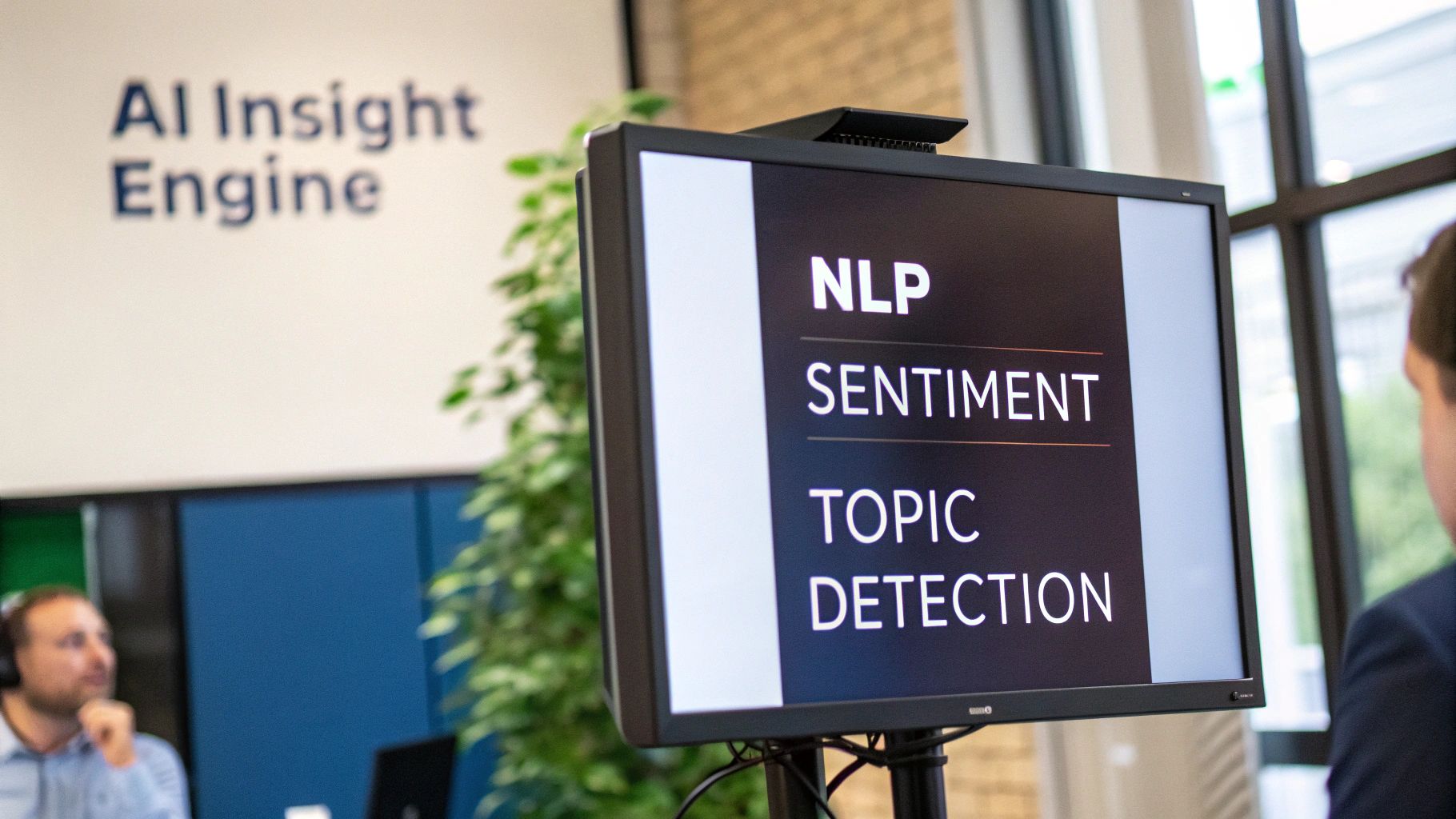
This isn't just about moving faster. It's about digging deeper. An AI can process 10,000 customer comments in the time it takes a person to get through maybe ten, spotting subtle trends and patterns that a human would almost certainly miss.
The AI Toolkit for Voice Analysis
Behind the scenes, a few core NLP techniques work in concert to make sense of all this feedback. Think of each one as a different lens that, when combined, gives you a rich, multi-dimensional view of the customer experience.
- Sentiment Analysis: This is your gut check. The AI automatically reads the emotional tone in a piece of text and flags it as positive, negative, or neutral. It’s how you can get an instant pulse on customer happiness and, for example, immediately spot a wave of negative comments after a new feature launch.
- Topic Modeling: Imagine having a brilliant assistant who could instantly sort thousands of customer messages into neat, organized piles. That’s topic modeling. It automatically identifies and groups recurring themes like "login issues," "billing questions," or "feature requests for integrations," so you can see exactly where the biggest pain points and opportunities are.
- Intent Recognition: This layer of analysis goes a step beyond just what a customer is saying to understand why they're saying it. It figures out what they’re trying to achieve. Are they asking for help ("How do I reset my password?"), giving a suggestion ("You should add a dark mode"), or even signaling that they're about to leave ("I'm canceling my subscription")?
The business world is taking notice. The voice analytics market, a huge piece of the customer voice analysis puzzle, was valued at around USD 1.13 billion in 2024. Projections show it rocketing to nearly USD 4.91 billion by 2034. This explosive growth is a direct result of companies realizing how crucial AI is for managing risk and truly improving customer relationships. For more on this trend, check out the full voice analytics market report from Expert Market Research.
From Raw Data to Revenue Insights
By weaving these AI methods together, modern platforms turn a chaotic stream of subjective feedback into a clear, prioritized action plan. An AI doesn't just tell you that 20% of feedback is negative. It tells you that 15% of that negative feedback is specifically about "slow loading times on the dashboard page" and that this issue is most frustrating for your highest-paying enterprise customers. Now that's an insight you can act on.
This is what modern business strategy looks like in action. To see more about how this works, take a look at our guide on AI-powered decision-making. At the end of the day, AI makes customer voice analysis scalable, objective, and directly tied to your bottom line, ensuring the most urgent problems and valuable opportunities always float to the top.
How to Turn Customer Insights Into Action
https://www.youtube.com/embed/k8BiWAnZiuc
Uncovering powerful insights is only half the battle. A brilliant customer voice analysis that just sits in a dashboard is nothing more than expensive data decoration. The real value is unlocked when those findings spark decisive action and drive meaningful changes across your organization. Without a clear game plan for implementation, even the most profound insights won't move the needle on your bottom line.
Think of it this way: a doctor can diagnose an illness, but without a prescription, the diagnosis is just information. It's the treatment plan that leads to recovery. The same principle applies here. Your goal should be to create a closed-loop system where customer feedback directly informs business strategy and product development.
It's not just about gathering data. The real magic happens when you utilize customer feedback for continuous improvement, turning what you hear into concrete strategies. This means building clear channels to get the right information to the right teams when they need it most.
Create Cross-Functional Action Teams
Insights often die in silos. A finding that touches product, marketing, and support needs a unified response, not a game of hot potato. To stop this from happening, create small, cross-functional "action teams" dedicated to tackling specific themes you uncover in your customer voice analysis.
For instance, if your analysis flags major frustration with your mobile app’s checkout process, an action team should probably include:
- A Product Manager: To own the feature redesign and get it on the roadmap.
- A UX/UI Designer: To map out a more intuitive flow based on what customers are saying.
- An Engineer: To figure out the technical lift and actually build the fix.
- A Customer Support Lead: To provide real-time context from frontline conversations.
This approach creates shared ownership and accountability. It breaks down the walls between departments and puts problem-solving on the fast track, moving an insight from a report into a project backlog with a clear owner.
Prioritize Based on Business Impact
Let's be honest: not all feedback is created equal. A minor bug reported by a hundred free-tier users is probably less critical than a major workflow issue blocking a $250,000 enterprise deal. The trick is to connect customer pain directly to business metrics like revenue, churn risk, and operational costs.
Modern AI-driven platforms are fantastic at this. They can automatically assign a dollar value to friction points and feature requests, giving you a data-driven way to prioritize what to tackle first.
Example Prioritization Framework:
- High Impact, Low Effort: These are your quick wins. Fix them immediately. You'll build momentum and show customers you're listening.
- High Impact, High Effort: These are big, strategic projects. They need serious planning and resources but promise a huge payoff.
- Low Impact, Low Effort: Handle these when you have some downtime, but don’t let them distract from the bigger fish.
- Low Impact, High Effort: These are the "nice-to-have" features that often need to be shelved or ignored entirely.
Using a framework like this transforms subjective feedback into an objective roadmap. It ensures your teams are always working on the changes that will actually drive growth and improve customer retention. When you consistently close the loop and show customers their voice leads to action, you build powerful, lasting loyalty.
Measuring the Success of Your Program
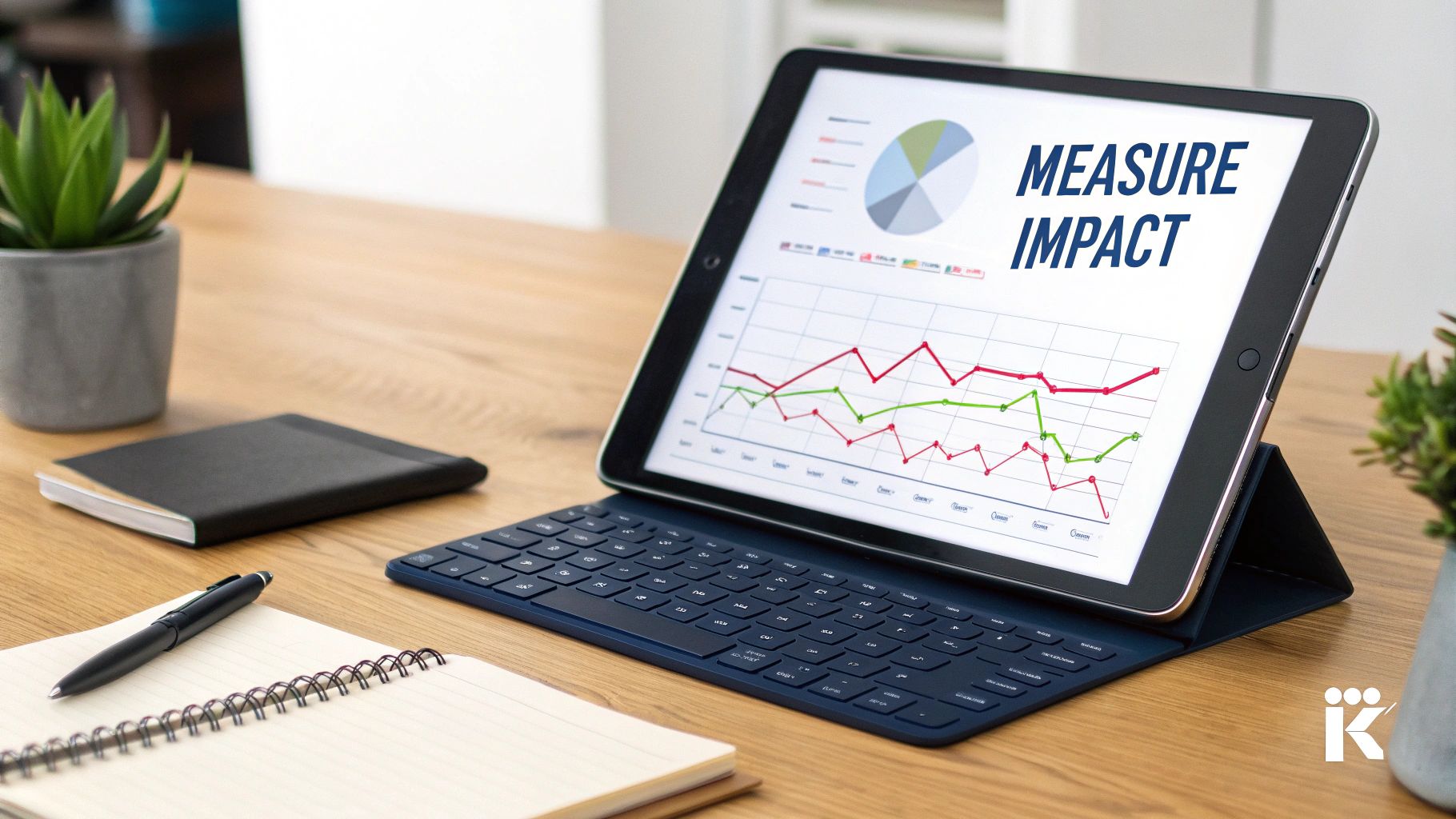
Running a customer voice program without tracking its impact is like flying blind. You might feel like you're heading in the right direction, but you have no real way to prove it. If you want to justify the investment and keep the program running, you have to connect your listening efforts to real-world business results.
This means looking beyond the usual suspects. While metrics like Net Promoter Score (NPS) and Customer Satisfaction (CSAT) are great for a quick pulse check on sentiment, they don’t tell the full story. To truly measure success, you need to draw a clear line from a specific insight you uncovered to a tangible improvement in a key performance indicator (KPI).
Key Metrics for Demonstrating ROI
To prove your customer voice analysis is actually worth it, you need to focus on metrics that matter to the business—the ones that speak directly to financial health. These are the numbers that bridge the gap between "happy customers" and a healthy bottom line, making the value of your work impossible to ignore.
Here are three powerful metrics you should get on your dashboard right away:
- Customer Effort Score (CES): This one is simple but incredibly insightful. It measures how easy you make it for customers to get help or find an answer. A lower score is what you're aiming for, as less effort almost always leads to higher loyalty and lower support costs.
- Churn Reduction by Theme: Don't just track your overall churn rate. Dig deeper. Attribute churn to the specific problems you’ve identified in your analysis. For instance, you can see how many customers left because of a "missing integration," and then watch that number drop after your team ships it.
- Sentiment Trend Analysis: Go beyond a single snapshot. Track the percentage of positive, negative, and neutral feedback over time for specific topics. Did sentiment around your "onboarding process" improve by 25% the quarter after you rolled out changes? That’s a clear win you can point to.
The technology behind this kind of analysis is booming. The broader voice and speech recognition market was valued at USD 14.8 billion in 2024 and is expected to climb to USD 61.27 billion by 2033. This growth is fueled by companies scrambling for better ways to understand and act on what customers are saying. You can dig into the numbers yourself in the full voice recognition market research.
Building Your Measurement Dashboard
A well-designed dashboard is your best friend for communicating value. It turns complex data into a clear story, showing the ROI of your work at a single glance. Your goal isn't just to report numbers; it's to show how listening to customers directly impacts the company's success.
By focusing on the right KPIs, you elevate customer feedback from a pile of opinions to a strategic asset. You can walk into any meeting and show, with confidence, that investing in the customer voice isn't just another expense—it's a direct driver of revenue, retention, and long-term growth.
Common Questions About Customer Voice Analysis
Even with a clear strategy, diving into customer voice analysis for the first time can feel a little daunting. Let's walk through some of the most common questions that pop up.
Think of this as a quick-reference guide to help you clear any final hurdles before you jump in.
What Is the Difference Between VoC and Customer Voice Analysis?
This is probably the most frequent point of confusion, but the distinction is actually pretty straightforward.
Voice of the Customer (VoC) is the big-picture strategy. It’s all about gathering feedback from every possible touchpoint—the surveys, the support tickets, the online reviews, all of it. It’s the raw material.
Customer voice analysis, on the other hand, is the work you do with that raw material. It’s the process of digging into the feedback, finding the patterns, and figuring out what it all means. It's the engine that turns a mountain of data into a handful of smart decisions.
Think of your VoC program as building a massive library of customer comments. The analysis is the act of actually reading the books, connecting the dots between them, and writing a clear summary of what your customers are really trying to tell you.
Simply put, analysis is what makes a VoC program valuable. Without it, you’re just collecting data for the sake of it.
How Can a Small Business Start Without a Big Budget?
You don't need a six-figure software budget to get started. Honestly, the most important first step is just building the habit of listening and systematically tracking what you hear.
Start with the feedback channels you already have. Make it a routine to check:
- Social Media Pages: What are people saying in your DMs, mentions, and comment sections?
- Online Review Sites: Are there common themes popping up on sites like G2 or Capterra?
- Support Emails and Chats: Ask your support team: what are the top three problems you solved this week?
You can even start with a simple spreadsheet. Manually tag recurring themes and keep a running tally. It’s not as fast or scalable as an AI platform, but it costs nothing and will absolutely surface critical insights right away. Doing this foundational work also makes it much easier to build a business case for a more powerful tool down the road.
What Are the Biggest Implementation Challenges?
Getting a customer voice analysis program off the ground is exciting, but a few common roadblocks can trip people up. Knowing what they are ahead of time is the best defense.
The three biggest challenges I see are:
- Data Silos: This is a classic. Customer feedback is sprinkled across the entire company. Support has its tickets, sales has its call notes, and marketing has its survey data. When everything is locked in different systems, you can never get a complete, unified view of the customer experience.
- Lack of Action: This is the most dangerous one. All the brilliant insights in the world are useless if nobody does anything with them. If your product team isn't empowered to fix the bugs you find, or if leadership ignores the feature requests you surface, the whole initiative will quickly lose steam and credibility.
- Poor Data Quality: The old saying "garbage in, garbage out" is especially true here. If your surveys ask leading questions, or if you're only getting feedback from a tiny, unrepresentative group of users, your conclusions will be shaky at best. Real success depends on a commitment to gathering clean, unbiased feedback from a healthy cross-section of your customer base.
Getting past these hurdles isn’t about technology—it’s about culture. It requires a shared commitment to bringing data together, creating clear workflows for acting on what you learn, and maintaining the quality of the feedback you collect.
Ready to stop guessing what your customers want? SigOS is an AI-driven product intelligence platform that analyzes support tickets, sales calls, and usage data to show you which issues are costing you money and which features will drive revenue. See how SigOS turns customer feedback into your biggest competitive advantage.
Keep Reading
More insights from our blog

